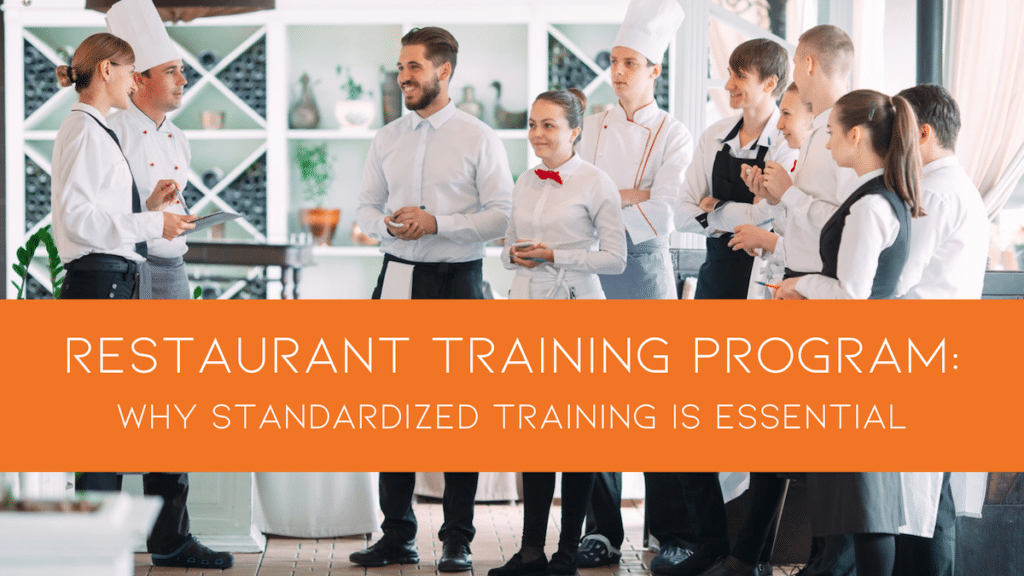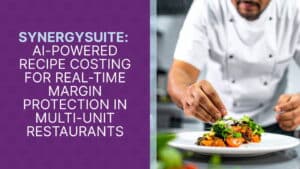Updated on: February 9, 2025
It’s no secret that running a great restaurant requires great employees and that the best employees benefit from the best restaurant training. While restaurants and restaurant managers can execute great training without a standardized restaurant training program, such a program is the only way to ensure it.
A quality, standardized restaurant training program is vital to any successful multi-location restaurant business. Not only do they provide many benefits, but they help you avoid many consequences of poor restaurant training.

The Benefits of a Great, Standardized Restaurant Training Program
A well-thought-out, standardized restaurant training program will benefit your organization. When you train new team members using an effective program, you ensure excellent customer service, food safety, and employee retention.
An excellent restaurant training program improves employee experience and retention
With the labor market currently challenging, hiring and then retaining good staff is necessary to ensure business growth. Implementing a quality restaurant staff training program is one of the top drivers of staff retention. A trained staff means happy customers and results in higher employee morale. Investing time into training communicates to your staff members that they’re valued, that you expect them to be around for a while, and that everyone is on the same page.
When there is no set training process, clear communication of expectations is absent, and expectations often go unmet. This can lead to unfulfilled staff and a high turnover rate. When great training programs are set, consistent, and individualized, your restaurant staff will better understand their roles and how to execute them effectively. We recommend onboarding training and online courses to help new hires and existing staff understand everything from your company culture to what is expected of them as employees in the fast-paced restaurant industry.
It improves customer satisfaction
A successful restaurant thrives on a repeatable system and service style. The more the system is practiced and perfected, the more enjoyable the employee and customer experience becomes. Restaurants are fast-paced environments. Orders must be taken quickly. Customers want their food promptly. And when it’s time to pay, they don’t want to wait around. If you combine this with delicious food, your restaurant’s reputation will spread.
Running a restaurant successfully can be daunting. So many moving parts are involved that a specific system and structure are needed to achieve a great customer experience. This is the basic idea of deploying a training program.
Your restaurant training and system, in general, must be created in a way that, when properly executed, leads to everything running like a well-oiled machine. The rewards of an efficient training system include satisfied customers, favorable reviews, a positive work environment, increased revenue, and an increase in your wait staff’s tips. However, failure to execute the system outlined in your training could potentially manifest disastrous results.
Standardized restaurant training programs increase efficiency across all locations
A good training program can help employees learn their tasks more quickly and efficiently, increasing the restaurant’s productivity and profitability. This isn’t just true when employees start working and need to get up to speed quickly; continued training can help even seasoned team members become more efficient, make fewer mistakes, and save time during shifts.
In addition, when implemented across all your locations, every employee can undergo the same training. Not all restaurant chains have policies that allow employees from one location to work in another, but those that do can see major benefits. When there is an emergency, an employee from one location can seamlessly jump in at another location without skipping a beat.
A great restaurant training program enhances your reputation
One indirect but powerful benefit of a great restaurant training program is that it leads to a great reputation for your restaurant. While your employees benefit from a strong employee experience, your customers also benefit from an enhanced customer experience. Combining the two means they’ll likely be back in your restaurant again, bringing their friends and family as well.
People who have a great experience tend to tell everyone they’re close to about it. This leads to more referral business and can also become a source of potential employees, as your team members will be happy to share their experience with others who might need a job. Especially today, when it can be challenging to keep up with recent labor shortages, this just might be a powerful solution to ensuring that you’ll have quality employees to help keep business flowing.
A standardized restaurant training programs makes life much easier for enterprise HR managers
As you boost your restaurant’s success and expand to more locations, training, and HR tasks become much more complicated. Managing employee onboarding, ongoing training, scheduling, and generally ensuring things run smoothly becomes quite a task. But with a quality and standardized training program for all your locations, you can ensure that everyone knows the systems and procedures needed to maintain a quality experience in each location, including the administrative items needed to manage human resources tasks properly.
What Are the Consequences of Poor Restaurant Training?
The potential consequences are seemingly endless for a restaurant staff that doesn’t receive the proper training. However, the most common negative results include:
Poor Customer Service
The customer suffers the most without a uniform system for the kitchen and the front of the house. Training must outline the ideal customer experience from beginning to end. Poor customer service could mean a variety of things, including lack of check-ins/drink refills, extended waiting for a table or for food to be prepared, unsatisfactory food quality, an unsanitary environment, and more.
Inconsistent restaurant training programs result in inconsistent restaurant culture
Your restaurant culture is a reflection of the mindset of your restaurant business. This includes how employees interact with one another, the respect level within your organization, and the overall environment, both away from the customers and while interacting with them. With no system to follow and no outline to adhere to, your restaurant culture is an unknown factor that will take a life of its own and produce unexpected results. Your restaurant culture is vital to your business, so it will always be best to deliberately outline and create that culture.
This is especially true when you have multiple franchises and locations and need the experience to be consistent across them all. If you don’t have a proper restaurant training program, the teams at each location will be trained differently, resulting in an inconsistent experience for employees and customers. If an employee or customer has an amazing experience at one location, nothing will kill their loyalty to your brand faster than having a different and negative experience at another.
Inefficiency and mistakes
When your employees lack a repeatable system to follow, inefficiency and mistakes become a regular occurrence. Employees can’t be expected to operate flawlessly when no standardized practice or system is followed. You end up with a group of individuals freestyling, resulting in inconsistent work output. One shift might be good, the next might be just okay, and the next could be terrible. A general lack of consistency is a direct path to a failing restaurant 99% of the time.
High Employee Turnover
Employees you hire, especially those who have experience, will be turned off by a lack of organization and a concrete system in place. Regardless of what anyone says, almost all employees want to be part of something special. People take pride in their work when they know they’re providing a valuable service. Without something to take pride in and the frustrations of an inefficient system, get used to a constant cycle of hiring, quitting, and rehiring.
Potential Legal or Safety Risks
If your training program isn’t consistent across all your locations, you won’t know what policies, procedures, or safety measures might not have been covered in training, and that can cause significant risks for major mistakes or accidents. Not only is it vitally important for every team member’s safety, which is the top priority, it can also lead to potential legal challenges that might halt your success and growth in a big way.

The Characteristics of a Quality Restaurant Training Program
Certain signs identify the presence of a quality restaurant staff training program. Here are some of the most notable from our experts:
Consistent
The best restaurant training programs implement consistent and regular training. While new employees expect to have a significant training block when they start, the training shouldn’t stop there. Training should continue constantly, consistently improving your processes and employees’ skills.
Your core training should be consistent from employee to employee and consistent and standardized across all your locations. Yes, each location should also be able to train on topics specific to its teams (which we’ll discuss later), but at its core, your restaurant training program should be the same at each franchise or location. One way to do this is for restaurant operators to create training videos that can be shown across locations.
Documented
Everything is documented and logged to ensure organization and efficient communication. Tasks, shifts, and any other vital information are documented. The only way a restaurant training program can remain consistent is to be documented, usually in an easily accessible manual.
While the training program itself should be documented, each employee’s progress as they work through the training program should also be recorded. This will help to ensure that every team member gets all the training available and that nothing is missed that could lead to mistakes and accidents later on.
Complete
A restaurant with the proper training will feel complete. This means that the employees will clearly understand what is expected of them and how to do their jobs without confusion. A “complete” training program doesn’t mean the training should end or more training is unnecessary; all the essential points for doing the job are covered, and additional training can build upon them.
Personalized, when needed
While consistent across your organization, the best training isn’t entirely one-size-fits-all and should be personalized for each employee. While the general topics might be uniform across the organization for different roles, each person will learn differently and have different training needs. On top of that, specific training may be needed for different positions. For example, a cook may need different position training than the wait staff. To make the most of your training program, managers and trainers should be able to adjust the training methods to help the employee learn best.
Continues
Your training system should be a continuing process that is open to changes and small adjustments. The last thing you want is to stagnate and for your employees to become complacent. Just because your staff is well-versed in your system doesn’t mean there’s no room for adjustments. And, just because your training program works doesn’t mean it can’t be improved. Always continue to look for new ways to improve on your training, and you’ll see the benefits in your organization.
Evolves
As time passes, there should always be room for your organization to evolve. This means your training system will evolve as well. This doesn’t mean you should stray from the central points that made your success possible in the first place – you want to keep your winning formula. However, evolution is a part of business; you will slowly die without growth.
A standardized and well-thought-out restaurant training program is necessary for any growing quick-service or fast-casual restaurant business. If you haven’t already, it’s time to buckle down and invest the time and resources needed to implement a quality program in your business.
Standardize an Improve Your Restaurant Training Program with HR Software for Restaurants
Restaurant HR software can help you create onboarding and training documents and checklists that ensure each employee’s training is current and that no important topics are missed. This can be especially useful when you manage the training of new employees across many locations, saving your HR department a lot of time and energy in tracking each new employee’s progress.
Managers can improve the restaurant’s overall operations by regularly reviewing and updating training documents in their restaurant’s HR software, ensuring all employees have the most current and accurate information.
Additional Topics for Your Restaurant Training Program
Your restaurant training program will likely cover a wide range of topics, and can be implemented in just as many ways. Check out more of our training program resources to make the most of your restaurant training program:
- Creating a Restaurant Training Manual
- Methods for Training Employees in Restaurants: Pros, Cons, and Tools
- Restaurant Employee Onboarding: How-to and Common Topics
- Role-Specific Restaurant Training in Quick-Service and Fast Casual Restaurants
- Continuing Restaurant Training After Onboarding
- Additional Training Topics for Restaurant Employees






